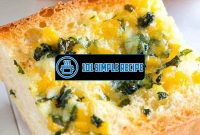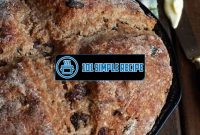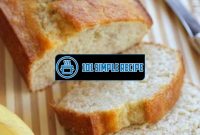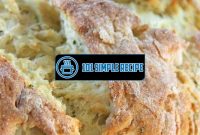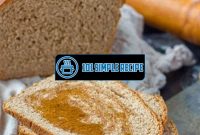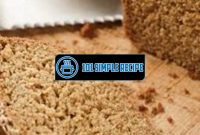Are you tired of the same old bread recipes? Look no further! In this article, you will discover a collection of delicious yeast-free bread recipes that are perfect for every occasion. Whether you have a gluten intolerance, dietary restrictions, or simply want to try something new, these recipes will surely satisfy your cravings. From fluffy banana bread to mouthwatering whole wheat bread, there’s a recipe here for everyone. So, put on your apron and get ready to embark on a bread-baking adventure like no other!
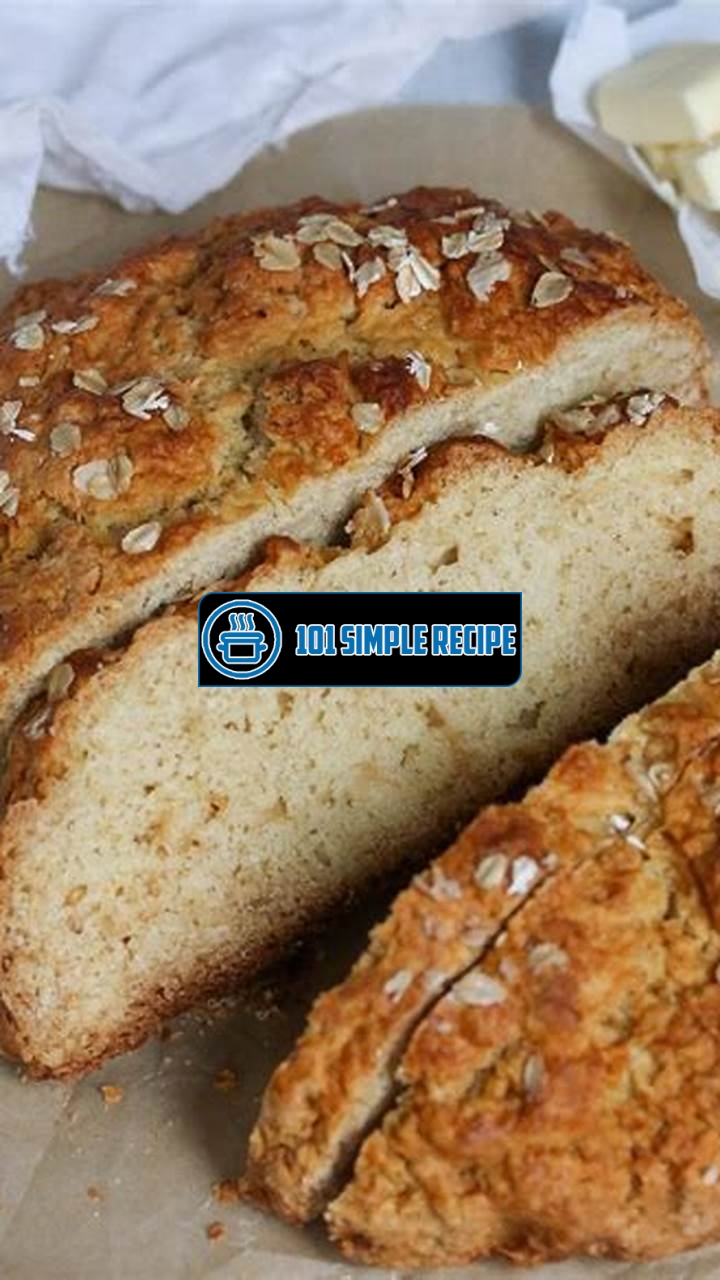
The Appeal of No Yeast Bread Recipes
Discover why no yeast bread recipes have gained popularity in recent years as a convenient and delicious alternative to traditional bread-making methods.
Why Choose No Yeast Bread?
No yeast bread has become a popular choice for many people due to its simplicity and ease of preparation. Unlike traditional bread, which requires yeast for the dough to rise, yeast-free bread recipes do not rely on this leavening agent. This means that you can skip the time-consuming process of proofing yeast and waiting for the dough to rise. Instead, you can have a fresh loaf of bread on your table in no time.⏱️
In addition to saving time, choosing no yeast bread also has health benefits. Yeast-free bread is often made with whole wheat or other whole grain flours, providing a higher fiber content compared to white bread. This can aid digestion, promote a feeling of fullness, and contribute to a balanced diet. Moreover, for individuals with yeast allergies or sensitivities, no yeast bread allows them to enjoy this staple food without experiencing adverse reactions.
Benefits of No Yeast Bread
There are several benefits to incorporating yeast-free bread into your diet. First and foremost, it offers a convenient solution when you crave fresh bread but are short on time. Whether you need a quick breakfast option, a sandwich for lunch, or a side dish for dinner, no yeast bread can be easily whipped up and enjoyed.
Furthermore, by using alternative leavening agents such as baking powder or baking soda, no yeast bread recipes eliminate the need for complex bread-making techniques. This makes them ideal for beginners or those who are intimidated by traditional yeast-based recipes. You don’t need to worry about activating yeast, kneading the dough, or waiting for it to rise. Just mix the ingredients, shape the dough, and bake it. Simple and foolproof!
Another advantage of no yeast bread is its versatility. You can experiment with various flavors and add-ins, such as herbs, cheese, nuts, or dried fruits, to create customized bread to suit your taste preferences. With no yeast as a limiting factor, the possibilities are endless. Whether you prefer savory or sweet, you can find a yeast-free bread recipe that satisfies your cravings.
Common Ingredients in No Yeast Bread Recipes
No yeast bread recipes typically call for a few staple ingredients that are pantry-friendly. Here are some common ingredients you might come across:
- Flour: Whole wheat flour, all-purpose flour, or a combination of both can be used as the base for yeast-free bread recipes.
- Baking Powder/Soda: These leavening agents are responsible for the rise in yeast-free bread. They work by releasing carbon dioxide gas when combined with liquid ingredients.
- Salt: Salt enhances the flavor of the bread and helps regulate the dough’s fermentation process.
- Liquid: Water, milk, buttermilk, or yogurt can be used to hydrate the dough and provide necessary moisture.
- Fat: Oil, melted butter, or even mashed bananas can add moisture and richness to yeast-free bread.
- Sweeteners: Depending on the desired flavor, you can add honey, maple syrup, sugar, or other sweeteners to the bread dough.
- Add-ins: Seeds, nuts, herbs, cheese, dried fruits, or even vegetables like zucchini or carrots can be incorporated to add texture and flavor to the bread.
With these readily available ingredients, you’ll be able to create a variety of delicious yeast-free breads to accompany your meals or enjoy as a snack.
In conclusion, the appeal of no yeast bread recipes lies in their convenience, health benefits, simplicity, and versatility. Whether you opt for no yeast bread due to time constraints, dietary restrictions, or personal preferences, you can still indulge in the pleasure of freshly baked bread without the need for intricate bread-making methods. Start exploring the world of yeast-free bread and discover the joy of homemade bread made easy.
Garlic Cheese Bread Recipe is a perfect accompaniment to your no yeast bread recipes.
Understanding the Science Behind No Yeast Bread
When it comes to baking bread, yeast is often the key ingredient responsible for its rise and fluffy texture. However, there are times when you may not have yeast on hand or prefer to avoid it for dietary or personal reasons. In such cases, understanding the science behind no yeast bread recipes becomes essential. By delving into the scientific principles that allow these recipes to rise without yeast, you can still enjoy delicious bread for any occasion.
Chemical Leaveners in No Yeast Bread
Chemical leaveners are substances that release carbon dioxide gas when combined with moisture and heat, causing the bread to rise. One popular chemical leavener used in yeast-free bread recipes is baking powder. Made from a combination of baking soda, cream of tartar, and sometimes cornstarch, baking powder acts as a raising agent. When it is mixed with the other ingredients in the bread dough, it produces carbon dioxide bubbles, resulting in a light and airy texture.
Another chemical leavener often used is baking soda, also known as sodium bicarbonate. When combined with an acidic ingredient, such as lemon juice or vinegar, baking soda produces carbon dioxide gas. This gas creates air pockets in the bread, leading to the desired rise. It is important to note that the acidic ingredient used should react with baking soda to create the necessary chemical reaction.
Natural Leavening Agents in No Yeast Bread
If you prefer to avoid chemical leaveners, there are natural alternatives that can achieve a similar effect. One common natural leavening agent is baking soda combined with an acidic ingredient, as mentioned earlier. This combination mimics the process of yeast fermentation and helps the bread rise.
Additionally, sourdough starter can be used as a natural leavening agent. Sourdough starter is a fermented mixture of flour and water that contains wild yeast and lactobacilli. The wild yeast in the starter feeds on the sugars in the dough, producing carbon dioxide gas and alcohol. This gas gets trapped in the bread, causing it to rise and imparting a unique flavor.
Factors That Influence Rising in No Yeast Bread
Several factors can influence the rising process in yeast-free bread recipes. Firstly, the type and ratio of ingredients used play a crucial role. For example, using a higher amount of leavening agents can lead to excessive rising and a collapsed final product. It is essential to follow the recipe’s instructions carefully and measure the ingredients accurately to achieve the desired texture.
The temperature and humidity of the environment also impact the rising process. Yeast-free bread dough needs a warm and moist setting to rise properly. If the environment is too cold or dry, the dough may not rise adequately. It is recommended to place the dough in a warm spot, such as near a heated oven or on top of a preheated surface, to create an optimal rising environment.
Finally, the mixing and kneading techniques used affect the bread’s rise. Properly mixing the ingredients ensures the leavening agents are evenly distributed throughout the dough. Kneading the dough activates the gluten strands and strengthens the structure, allowing it to trap the carbon dioxide bubbles during rising.
In conclusion, understanding the science behind no yeast bread recipes provides insights into the various leavening agents and factors that contribute to their rise and fluffy texture. Whether using chemical leaveners or natural alternatives, following the correct techniques and measurements are vital for successful bread-making. So why not experiment with these yeast-free recipes and discover the joy of baking delicious bread for every occasion?
Peanut Butter Cup Recipe is a delicious treat that you can make at home.
Baking Techniques for No Yeast Bread
When it comes to making delicious yeast-free bread, mastering the right baking techniques is key. Whether you’re a seasoned baker or just starting out, understanding the various methods can help you achieve the best results every time. In this article, we will explore three popular baking techniques for no yeast bread: the Quick Bread Method, the Biscuit Method, and the Dutch Oven Method.
Quick Bread Method
The Quick Bread Method is a versatile technique that allows you to whip up a loaf of bread in no time. It involves combining the dry ingredients, such as flour, baking powder, and salt, with the wet ingredients, such as milk, oil, or butter. Unlike traditional yeast bread, quick bread leavens through the use of baking powder or baking soda, which creates air bubbles and gives the bread its light and fluffy texture.
⭐️ Notable Point: The Quick Bread Method is perfect for making savory breads like cornbread or sweet breads like banana bread.
Biscuit Method
The Biscuit Method is commonly used to make biscuits, but it can also be used to create delicious yeast-free bread. This technique involves cutting cold butter or shortening into the dry ingredients until it resembles coarse crumbs. Then, a liquid, such as milk or buttermilk, is added to form a soft dough. The key to achieving a tender and flaky texture with the Biscuit Method is to handle the dough as little as possible to prevent the butter from melting.
⭐️ Notable Point: The Biscuit Method is ideal for making bread rolls or flaky breads like scones.
Dutch Oven Method
The Dutch Oven Method is a unique technique that allows you to bake bread without the need for a traditional oven. This method involves using a heavy, cast-iron pot with a lid, which creates a steamy environment inside the pot. The steam helps the bread rise and develop a crispy crust. To use this technique, simply shape the bread dough and let it rise. Then, preheat the Dutch oven, place the dough inside, cover it with the lid, and bake it over a stovetop or open fire.
⭐️ Notable Point: The Dutch Oven Method is great for making artisan-style bread with a crusty exterior and a soft interior.
In conclusion, understanding the different baking techniques for no yeast bread can greatly improve your bread-making skills. Whether you prefer the simplicity of the Quick Bread Method, the flakiness of the Biscuit Method, or the rustic charm of the Dutch Oven Method, these techniques offer a wide range of options for you to explore. So, roll up your sleeves, gather your ingredients, and get ready to bake some delicious yeast-free bread!
Hershey Chocolate Cake Recipe is a must-try for chocolate lovers.
Tips and Tricks for Perfecting No Yeast Bread
Are you looking to bake delicious yeast-free bread that turns out perfectly every time? Look no further! In this article, we will explore expert tips and tricks to help you achieve amazing results with your no yeast bread recipes. From troubleshooting common problems to enhancing flavors, we’ve got you covered. Let’s dive in!
Troubleshooting Common Problems
Even the most experienced bakers can face challenges when making yeast-free bread. Here are some common problems you may encounter along with their solutions:
- Dense and Heavy Texture: If your bread turns out too dense and heavy, try adding a little more liquid to the dough. This will help create a lighter and fluffier texture. Remember to adjust the other ingredients accordingly.
- Crumbly Bread: Crumbly bread can be a result of using too much flour or not enough binding ingredients. Ensure that you are using the correct measurements and follow the recipe carefully. Adding an extra egg or a tablespoon of oil can also help improve the bread’s texture.
- Lack of Rise: If your bread doesn’t rise as expected, it may be due to inactive baking powder or soda. Check the expiration date of your leavening agents and make sure they are fresh. Additionally, avoid over-mixing the dough as it can deflate the air bubbles necessary for rising.
Pro Tip: If you’re unsure about the freshness of your baking powder or soda, perform a simple test. Add a teaspoon of baking powder to a cup of hot water. If it fizzes vigorously, it is still active.
Enhancing Flavor in No Yeast Bread
No yeast bread can be just as flavorful and delicious as traditional yeast bread. Here are some ways to maximize the taste of your creations:
- Herbs and Spices: Add a dash of your favorite herbs and spices to infuse your bread with aromatic flavors. Rosemary, thyme, garlic powder, or paprika can bring a whole new dimension to your bread.
- Cheese and Onion: For a savory twist, consider adding grated cheese and finely chopped onions to your dough. These ingredients not only enhance the taste but also provide a pleasant texture.
- Sweet Additions: If you prefer sweeter bread, experiment with adding dried fruits, nuts, or chocolate chips to your dough. They will add bursts of flavor and make your bread more enjoyable.
Pro Tip: Don’t be afraid to get creative with your flavor combinations! Mix and match different ingredients to create unique bread recipes tailored to your taste preferences.
Storing and Freezing No Yeast Bread
Once you’ve baked your delicious yeast-free bread, you’ll want to ensure it stays fresh for as long as possible. Here are some guidelines for storing and freezing your bread:
- Storage: To keep your bread fresh, store it in an airtight container or a resealable bag at room temperature. Avoid keeping it in the refrigerator, as it can lead to faster staling.
- Freezing: No yeast bread freezes well, allowing you to enjoy it at a later time. Slice the bread before freezing it to make it easier to thaw individual portions. Wrap each slice tightly in plastic wrap or foil, and place them in a freezer-safe bag or container. Frozen bread can be toasted or thawed at room temperature when needed.
Pro Tip: Label your frozen bread with the date to keep track of its freshness. It is recommended to consume frozen bread within three months for the best quality.
By following these tips and tricks, you can perfect your yeast-free bread recipes, troubleshoot common problems, enhance flavors, and store your bread to maintain freshness. So go ahead, get creative in the kitchen, and enjoy the delightful world of yeast-free bread!
Delicious Variations of No Yeast Bread
Get inspired by a collection of mouthwatering no yeast bread recipes that showcase the versatility and culinary possibilities of this trend.
Classic Herbed Focaccia
One of the most popular variations of no yeast bread is the classic herbed focaccia. This savory bread is seasoned with a delightful blend of herbs, creating a flavorful and aromatic experience. The dough is typically made with ingredients such as flour, water, olive oil, salt, and baking powder. After kneading and shaping the dough, it is topped with a generous amount of olive oil, herbs like rosemary and thyme, and a sprinkle of sea salt. The bread is then baked to perfection, resulting in a golden crust with a soft and fluffy interior. It pairs perfectly with soups, salads, or can be enjoyed on its own as a delicious snack.
Don’t forget to use fresh herbs for maximum flavor!
Savory Garlic and Cheddar Loaf
If you’re a fan of garlic and cheese, then this savory garlic and cheddar loaf is a must-try. This bread is loaded with bold flavors and is perfect for serving alongside pasta dishes, soups, or enjoyed as a tasty sandwich bread. The dough is made with a combination of flour, baking powder, salt, butter, milk, garlic powder, and shredded cheddar cheese. Once baked, the loaf emerges from the oven with a beautiful golden crust and a gooey, melted cheese center. It’s a crowd-pleaser that will have everyone coming back for seconds.
Get creative with your cheese choices – try using a mix of different cheeses for added depth of flavor!
Sweet Cinnamon Swirl Bread
For those with a sweet tooth, this sweet cinnamon swirl bread is a delightful treat. It’s perfect for breakfast or as an afternoon snack. The dough is made with flour, sugar, baking powder, salt, milk, and melted butter. After the dough is rolled out, it is generously spread with a cinnamon-sugar mixture. It is then tightly rolled and twisted into a beautiful swirl shape. Once baked, the bread fills your home with the comforting aroma of cinnamon. It can be enjoyed as is or toasted and spread with butter for an extra indulgence.
The smell of freshly baked cinnamon bread is irresistible!
These delicious variations of no yeast bread are just a few examples of the culinary possibilities without using yeast. They prove that you don’t need yeast to create flavorful and satisfying breads. Whether you prefer savory or sweet, there’s a no yeast bread out there that will surely tickle your taste buds.
Frequently Asked Questions
If you have any more questions about no yeast bread recipes, we’re here to help! Take a look at the FAQs below for more information:
| No. | Questions | Answers |
|---|---|---|
| 1. | Can I make bread without yeast? | Absolutely! There are plenty of no yeast bread recipes available that use alternative leavening agents like baking powder or baking soda. |
| 2. | What are some examples of no yeast bread recipes? | Some popular examples include soda bread, banana bread, and cornbread, all of which can be made without yeast. |
| 3. | Do I need any special equipment to make no yeast bread? | No, most no yeast bread recipes can be made with basic kitchen tools like mixing bowls, measuring cups, and an oven. |
| 4. | Are no yeast bread recipes gluten-free? | Not all no yeast bread recipes are gluten-free, but there are many gluten-free options available that use alternative flours like almond flour or rice flour. |
| 5. | How long does it take to make no yeast bread? | The time it takes to make no yeast bread can vary depending on the recipe, but most can be made in under an hour. |
| 6. | Can I customize no yeast bread recipes? | Absolutely! No yeast bread recipes are a great base for adding your own personal touch. Get creative with herbs, spices, and mix-ins. |
Thanks for Reading!
We hope you found these no yeast bread recipes helpful and inspiring. Whether you’re looking for a quick and easy weekday bread or a special homemade treat, there’s something for everyone. Remember to bookmark this page and visit us again later for more delicious recipes and cooking tips. Happy baking!
Jump to Recipe
No Yeast Bread Recipes

Discover a variety of delicious no yeast bread recipes that can be easily made at home. From soda bread to banana bread, these recipes are perfect for any occasion.
- 2 cups all-purpose flour
- 2 teaspoons baking powder
- 1/2 teaspoon salt
- 1 cup milk
- 2 tablespoons oil
- 1 tablespoon honey
- Preheat the oven to 375°F (190°C). Grease a loaf pan and set aside.
- In a large mixing bowl, combine the flour, baking powder, and salt.
- In a separate bowl, whisk together the milk, oil, and honey.
- Pour the wet ingredients into the dry ingredients and stir until just combined.
- Transfer the dough to the greased loaf pan and smooth the top.
- Bake for 40-45 minutes or until golden brown and a toothpick inserted into the center comes out clean.
- Remove from the oven and let cool in the pan for 10 minutes. Transfer to a wire rack to cool completely before slicing.
- Serve and enjoy!

